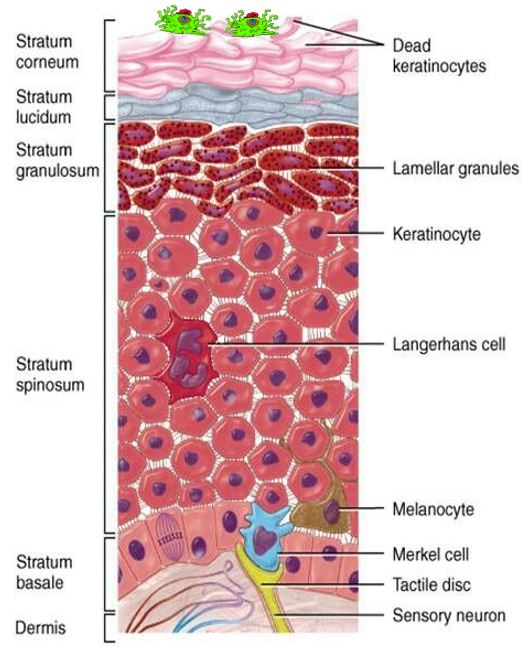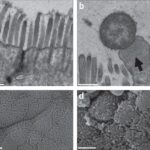Clostridium species are anaerobic, spore-forming, gram-positive bacilli found ubiquitously in soil, the gastrointestinal tract, and human skin. Certain species, particularly Clostridium perfringens, Clostridium septicum, and Clostridium sordellii, are highly pathogenic and associated with severe skin and skin structure infections (SSSIs), including cellulitis, fasciitis, and life-threatening gas gangrene (Clostridial myonecrosis).
These infections typically arise from contaminated wounds, traumatic injuries, or surgical procedures, progressing rapidly in immunocompromised or vulnerable patients. Prompt diagnosis and aggressive intervention are crucial to preventing systemic toxicity and mortality.

Pathogenesis and Virulence of Clostridium in SSTIs
Clostridium species produce potent exotoxins, enabling rapid tissue destruction, inflammation, and systemic toxicity. Key mechanisms include:
- Alpha-toxin (lecithinase): Lyses cell membranes and causes tissue necrosis (C. perfringens)
- Theta-toxin: Disrupts vascular integrity, promoting anaerobic spread
- Spore formation: Allows persistence in hostile environments and delayed onset
- Gas production: Results from anaerobic metabolism, characteristic of gas gangrene
- Collagenase and proteases: Facilitate deep tissue invasion and spread
These virulence factors contribute to rapid clinical deterioration and high mortality in untreated cases.
Clinical Presentations of Clostridium Skin and Structure Infections
1. Clostridial Cellulitis
- Localized erythema, swelling, and foul-smelling discharge
- Often follows trauma or surgery
- May progress slowly with minimal systemic signs
2. Clostridial Myonecrosis (Gas Gangrene)
- Severe pain, rapid swelling, crepitus from gas in tissues
- Skin discoloration, bullae, and serosanguinous exudate
- Systemic features: fever, tachycardia, hypotension, delirium
- Requires emergent surgical and antimicrobial therapy
3. Necrotizing Fasciitis
- Involves fascia with minimal skin changes initially
- Rapidly progressive with systemic toxicity
- May be polymicrobial, including Clostridium species
Risk Factors and Susceptible Populations
- Open traumatic wounds contaminated with soil or feces
- Surgical incisions, especially in bowel-related procedures
- Injection drug use
- Diabetes mellitus and peripheral vascular disease
- Malignancy or immunosuppression
- Obstetric complications, particularly involving C. sordellii
Early identification in these high-risk groups is essential to reduce morbidity and mortality.
Diagnostic Strategies for Clostridium Skin Infections
Laboratory Investigations
- Gram stain: Gram-positive rods without leukocytes suggest Clostridium
- Anaerobic wound culture: Definitive identification and sensitivity testing
- Blood cultures: Frequently positive in systemic infections
- Toxin assays: May be used in specialized reference laboratories
- Serum lactate and creatine kinase (CK): Elevated in necrosis and myonecrosis
Imaging
- Plain radiographs: May show gas in soft tissues
- CT or MRI: Defines the extent of infection and guides surgical intervention
Recommended Antimicrobial Therapy
Empirical Treatment
Initiate broad-spectrum antibiotics immediately upon clinical suspicion:
- Penicillin G + Clindamycin: Standard for C. perfringens; clindamycin inhibits toxin production
- Carbapenems or Beta-lactam/beta-lactamase inhibitors for polymicrobial infections
- Metronidazole or chloramphenicol as alternatives in beta-lactam allergy
Targeted Therapy
Adjust based on culture and sensitivity results. Duration typically extends:
- 10–14 days for uncomplicated cellulitis
- ≥4 weeks for myonecrosis or necrotizing infections, often with surgical debridement
Surgical Management and Wound Care
- Urgent surgical exploration and extensive debridement are essential
- Amputation may be required in advanced myonecrosis
- Wound irrigation, negative pressure therapy, and secondary closure
- Repeat debridement every 24–48 hours as indicated
Surgery remains the cornerstone of management in all necrotizing and gas-forming Clostridial infections.
Hyperbaric Oxygen Therapy (HBOT)
HBOT delivers 100% oxygen at high pressures, inhibiting anaerobic bacteria and enhancing neutrophil function and wound healing.
Indications:
- Adjunctive therapy in Clostridial myonecrosis
- Availability in specialized centers
- Requires multiple sessions with concurrent surgical and antimicrobial care
Prognosis and Outcomes
The prognosis depends on the type of infection and timeliness of intervention:
| Infection Type | Mortality Rate | Prognosis Factors |
|---|---|---|
| Clostridial Cellulitis | Low | Good with antibiotics and debridement |
| Gas Gangrene | 20–50% | Delayed surgery, systemic toxicity worsen outcome |
| Necrotizing Fasciitis | 25–35% | Multiorgan dysfunction, comorbidities |
Early diagnosis, aggressive debridement, and appropriate antibiotic therapy are pivotal in improving outcomes.
Infection Control and Prevention Measures
- Meticulous wound care and aseptic technique in trauma and surgery
- Sterilization of surgical instruments and obstetric tools
- Timely closure of wounds with proper drainage
- Antibiotic prophylaxis in high-risk surgeries (e.g., bowel resections)
- Surveillance cultures in ICU and post-operative wards
- Public health reporting for outbreaks of gas gangrene
Skin and skin structure infections caused by Clostridium species represent a clinical emergency, especially in cases of gas gangrene and necrotizing infections. The success of treatment hinges on rapid recognition, early empiric antimicrobial therapy, aggressive surgical debridement, and, when available, adjunctive hyperbaric oxygen therapy. Enhanced awareness and strict infection control protocols are essential to prevent these devastating infections in both community and healthcare settings.

